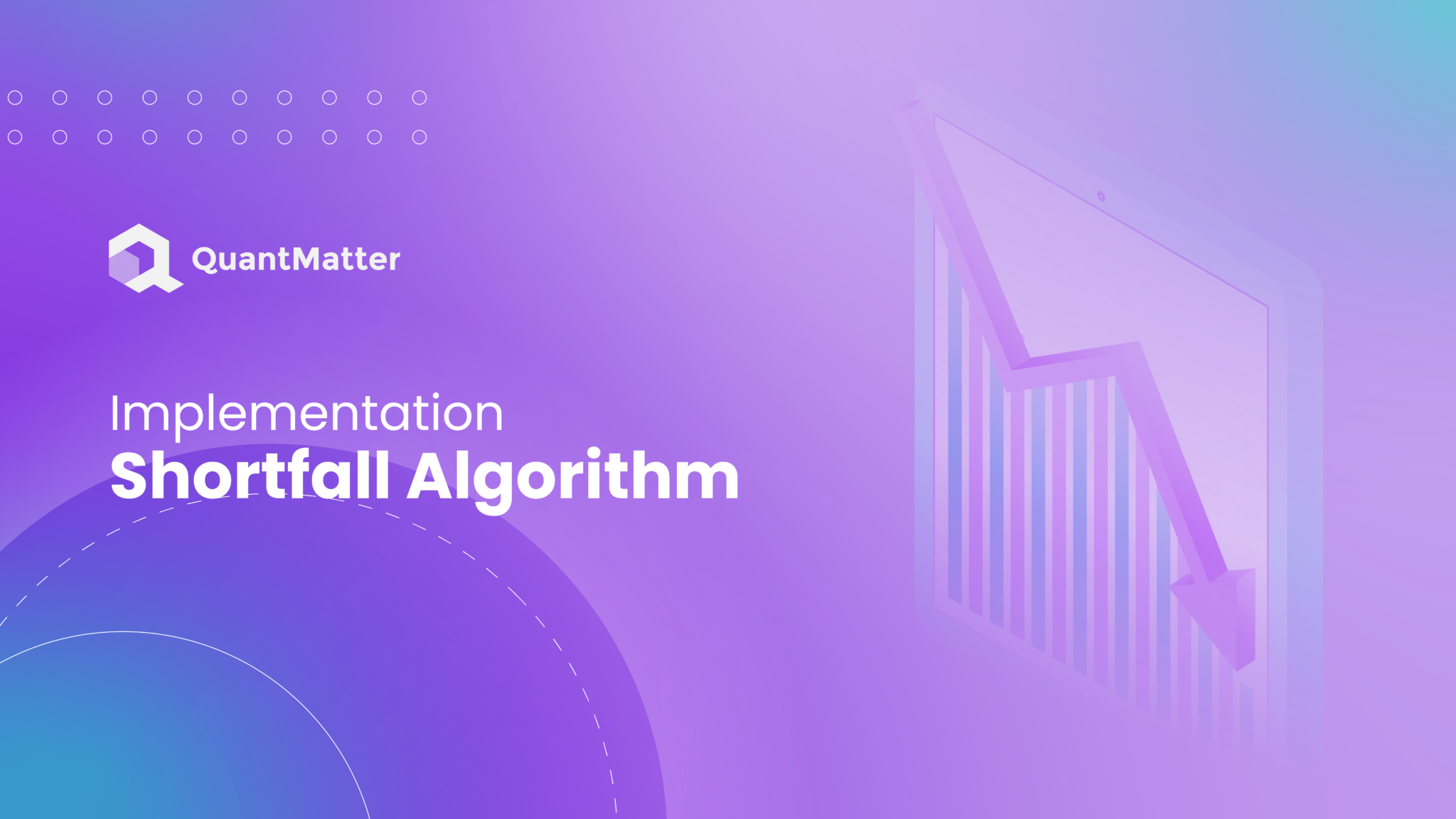
The world of finance has seen a significant transformation with the advent of algorithmic trading. Among the various algorithms used, the implementation shortfall algorithm stands out for its efficiency in minimizing trading costs. This algorithm is designed to reduce the difference between the theoretical trade price and the actual executed trade price.
Understanding the implementation shortfall algorithm is crucial for traders looking to optimize their strategies and enhance their returns. It provides a systematic approach to executing large orders with minimal market impact, which is essential in today’s fast-paced trading environment.
In this article, we will delve into the implementation shortfall algorithm, exploring its importance, how it works, its benefits, and its practical applications in modern trading. By the end, you will have a comprehensive understanding of this algorithm and its role in the financial markets.
The Importance of Implementation Shortfall in Trading

In trading, execution costs can significantly impact the overall profitability of a strategy. The implementation shortfall, also known as slippage, refers to the difference between the expected price of a trade and the actual price at which the trade is executed. This shortfall can erode potential profits or increase losses if not properly managed. Therefore, understanding and minimizing implementation shortfall is crucial for traders aiming to optimize their performance.
Understanding Execution Costs
Execution costs are a significant concern for traders, as they directly affect the profitability of trades. These costs include explicit costs like commissions and fees, as well as implicit costs such as the market impact of a trade. Managing these costs effectively is crucial for achieving optimal trading performance. By understanding and controlling execution costs, traders can better preserve their expected returns and improve their overall trading outcomes.
The Role of Market Volatility
Market volatility is one of the primary contributors to implementation shortfall. High volatility can lead to rapid price changes, making it challenging to execute trades at the desired price. The implementation shortfall algorithm helps mitigate this by carefully timing trades to minimize the impact of market fluctuations. By strategically executing trades during periods of lower volatility, traders can achieve better execution prices and reduce the risk of significant price deviations.
The Challenge of Large Orders
Executing large orders can be particularly challenging due to their potential to move the market. Breaking down large orders into smaller, more manageable chunks helps reduce their impact on the market price. The implementation shortfall algorithm uses sophisticated techniques to determine the optimal order sizes and execution times. This approach not only minimizes market impact but also ensures that trades are executed in a more efficient and cost-effective manner.
Also Read: Quantitative Analysis in Python: Practical Applications in Finance
The importance of managing implementation shortfall cannot be overstated. By leveraging advanced algorithms and techniques, traders can significantly reduce execution costs and enhance their overall trading performance. The implementation shortfall algorithm plays a vital role in this process, providing traders with the tools they need to achieve better execution prices and optimize their trading strategies.
How the Implementation Shortfall Algorithm Works

The implementation shortfall algorithm is designed to minimize the gap between the expected trade price and the actual execution price. This algorithm works by strategically managing the trade execution process to reduce the market impact and slippage.
Breaking Down Large Orders
One of the key techniques used by the implementation shortfall algorithm is breaking down large orders into smaller, more manageable chunks. Executing large orders all at once can lead to significant market impact, causing prices to move unfavorably. By breaking these orders into smaller pieces, the algorithm reduces the risk of adversely affecting the market price. Each smaller order is executed incrementally, which minimizes the likelihood of substantial price movements caused by the trade. This approach helps in achieving a more favorable execution price overall, ensuring that the trader’s objectives are met with minimal disruption to the market.
Timing of Trades
Timing is crucial when it comes to minimizing implementation shortfall. The algorithm carefully analyzes market conditions to determine the optimal times to execute trades. By executing trades during periods of lower volatility or higher liquidity, the algorithm can reduce the market impact and achieve better execution prices. For example, trading during times when the market is less active can help avoid sudden price swings. Conversely, trading during periods of higher liquidity ensures that there are enough buyers and sellers to absorb the trade without significantly moving the price. This precise timing helps in reducing the difference between the expected and actual trade prices.
Dynamic Adjustment
The implementation shortfall algorithm is dynamic and adapts to changing market conditions. It continuously monitors the market and adjusts the execution strategy in real-time. This flexibility allows the algorithm to respond to unexpected market movements and optimize the trade execution process accordingly. For instance, if the market becomes more volatile than anticipated, the algorithm can pause or slow down the execution to avoid adverse price impacts. Similarly, if the market conditions become more favorable, it can accelerate the trade execution to take advantage of better prices. This dynamic adjustment capability is key to minimizing implementation shortfall in a rapidly changing market environment.
Use of Historical Data
Historical market data plays a significant role in the functioning of the implementation shortfall algorithm. By analyzing past trading patterns and market behaviors, the algorithm can make informed decisions about order sizes, timing, and execution strategies. This data-driven approach enhances the algorithm’s effectiveness in minimizing implementation shortfall. For example, historical data can reveal times of the day or days of the week when trading is typically more favorable. By leveraging this information, the algorithm can plan and execute trades more effectively, ensuring that past insights contribute to present success.
The implementation shortfall algorithm employs a combination of techniques to optimize trade execution. By breaking down large orders, timing trades strategically, dynamically adjusting to market conditions, and utilizing historical data, the algorithm effectively minimizes the gap between expected and actual trade prices. This results in more efficient and cost-effective trading, ultimately enhancing the trader’s overall performance.
Benefits of Using the Implementation Shortfall Algorithm

The implementation shortfall algorithm offers numerous advantages that can significantly enhance trading efficiency and profitability. By leveraging this algorithm, traders can achieve better execution prices and reduce overall trading costs.
Minimizing Market Impact
One of the primary benefits of the implementation shortfall algorithm is its ability to minimize market impact. Large orders can cause substantial price movements, leading to less favorable execution prices. The algorithm mitigates this by breaking down large orders into smaller parts and executing them incrementally. This approach ensures that each smaller order has a minimal effect on the market price, allowing the trader to achieve a more favorable overall execution price.
Reducing Slippage
Slippage occurs when there is a difference between the expected price of a trade and the actual executed price. The implementation shortfall algorithm helps reduce slippage by optimizing the timing and size of each trade. By carefully analyzing market conditions and historical data, the algorithm can execute trades at times and in sizes that are less likely to cause significant price deviations. This leads to more predictable and stable execution prices, which is crucial for maintaining the profitability of trading strategies.
Enhanced Trade Execution
The algorithm’s dynamic adjustment capability allows for enhanced trade execution. By continuously monitoring market conditions and adjusting execution strategies in real-time, the algorithm ensures that trades are executed in the most efficient manner possible. This adaptability is particularly important in volatile markets, where conditions can change rapidly. The ability to respond to these changes in real-time helps traders avoid adverse price movements and achieve better execution outcomes.
Cost Efficiency
Using the implementation shortfall algorithm can lead to significant cost savings. By minimizing market impact and reducing slippage, the algorithm helps traders achieve better execution prices, which directly translates to lower trading costs. Additionally, the algorithm’s ability to optimize trade execution timing and order sizes means that traders can avoid unnecessary fees and charges associated with poor execution. Overall, the algorithm provides a cost-efficient solution for managing large orders and complex trading strategies.
Data-Driven Decision Making
The implementation shortfall algorithm leverages historical market data to inform its execution strategies. This data-driven approach ensures that the algorithm’s decisions are based on empirical evidence rather than guesswork. By analyzing past trading patterns and market behaviors, the algorithm can make more accurate predictions about optimal execution times and order sizes. This leads to more informed and effective trading decisions, ultimately enhancing the trader’s performance.
Also Read: What is Quant Reading List Numerical Methods?
The implementation shortfall algorithm offers a range of benefits that can significantly improve trading outcomes. By minimizing market impact, reducing slippage, enhancing trade execution, improving cost efficiency, and enabling data-driven decision making, the algorithm provides a powerful tool for traders looking to optimize their strategies and achieve better results in the financial markets.
Practical Applications in Modern Trading

The implementation shortfall algorithm is widely used in various aspects of modern trading, offering practical solutions for different trading scenarios. Its ability to optimize trade execution makes it a valuable tool for both institutional and individual traders.
Institutional Trading
Institutional traders, such as mutual funds, pension funds, and hedge funds, often deal with large orders that can significantly impact the market. The implementation shortfall algorithm helps these institutions execute large trades without causing substantial price movements. By breaking down large orders into smaller ones and executing them strategically, the algorithm minimizes market impact and ensures that the trades are executed at the most favorable prices. This is crucial for maintaining the value of the funds and achieving the best possible returns for investors.
Algorithmic Trading Strategies
Algorithmic trading strategies rely heavily on the implementation shortfall algorithm to optimize execution. High-frequency trading firms and quantitative traders use this algorithm to execute large volumes of trades quickly and efficiently. The algorithm’s ability to dynamically adjust to real-time market conditions ensures that trades are executed at the best possible prices, even in fast-moving markets. This is particularly important for strategies that depend on small price differences and high turnover rates, as even minor execution improvements can lead to significant profit increases.
Risk Management
Risk management is a critical component of any trading strategy. The implementation shortfall algorithm helps traders manage risk by ensuring that trades are executed in a manner that minimizes potential losses. By reducing market impact and slippage, the algorithm helps traders avoid unfavorable price movements that can lead to significant losses. Additionally, the algorithm’s data-driven approach allows traders to make more informed decisions, further enhancing their ability to manage risk effectively.
Portfolio Rebalancing
Portfolio rebalancing involves adjusting the weights of assets in a portfolio to maintain a desired risk and return profile. The implementation shortfall algorithm is particularly useful for this process, as it allows traders to execute the necessary trades with minimal market impact. By breaking down and strategically timing the trades, the algorithm ensures that the portfolio is rebalanced efficiently and cost-effectively, preserving the intended investment strategy.
Market Making
Market makers play a crucial role in providing liquidity to financial markets. The implementation shortfall algorithm aids market makers by enabling them to execute large volumes of trades with minimal market impact. This helps maintain tight bid-ask spreads and ensures that market makers can fulfill their role of providing liquidity without incurring significant costs. The algorithm’s ability to dynamically adjust to market conditions also allows market makers to respond quickly to changes in supply and demand, maintaining their competitive edge.
The implementation shortfall algorithm has numerous practical applications in modern trading. Its ability to optimize trade execution makes it a valuable tool for institutional trading, algorithmic trading strategies, risk management, portfolio rebalancing, and market making. By leveraging this algorithm, traders can achieve better execution prices, reduce trading costs, and enhance their overall performance in the financial markets.
Conclusion
In the fast-paced world of modern trading, achieving optimal execution is paramount. The implementation shortfall algorithm has emerged as a crucial tool for traders looking to minimize the difference between expected and actual trade prices. By strategically managing trade execution, this algorithm helps reduce market impact and slippage, leading to more efficient and cost-effective trading outcomes. Understanding and effectively utilizing this algorithm is essential for traders who wish to optimize their strategies and enhance their performance.
The benefits of using the implementation shortfall algorithm are manifold. It helps minimize market impact, reduces slippage, enhances trade execution, improves cost efficiency, and facilitates data-driven decision-making. These advantages make it an indispensable tool for institutional traders, algorithmic traders, risk managers, portfolio managers, and market makers alike. In practical applications, from institutional trading and algorithmic strategies to risk management and market making, the algorithm provides a robust solution for optimizing trade execution, ensuring that trades are executed at the best possible prices.
In summary, the implementation shortfall algorithm is a critical component of modern trading strategies. Its role in minimizing execution costs and enhancing trading efficiency cannot be overstated. As traders continue to seek ways to improve their performance in increasingly competitive markets, the implementation shortfall algorithm will remain a key tool in their arsenal, driving better execution and ultimately, better results. By leveraging this algorithm, traders can achieve more predictable and stable execution prices, significantly improving their overall trading outcomes.
Disclaimer: The information provided by Quant Matter in this article is intended for general informational purposes and does not reflect the company’s opinion. It is not intended as investment advice or a recommendation. Readers are strongly advised to conduct their own thorough research and consult with a qualified financial advisor before making any financial decisions.

Joshua Soriano
As an author, I bring clarity to the complex intersections of technology and finance. My focus is on unraveling the complexities of using data science and machine learning in the cryptocurrency market, aiming to make the principles of quantitative trading understandable for everyone. Through my writing, I invite readers to explore how cutting-edge technology can be applied to make informed decisions in the fast-paced world of crypto trading, simplifying advanced concepts into engaging and accessible narratives.
- Joshua Soriano#molongui-disabled-link
- Joshua Soriano#molongui-disabled-link
- Joshua Soriano#molongui-disabled-link
- Joshua Soriano#molongui-disabled-link
